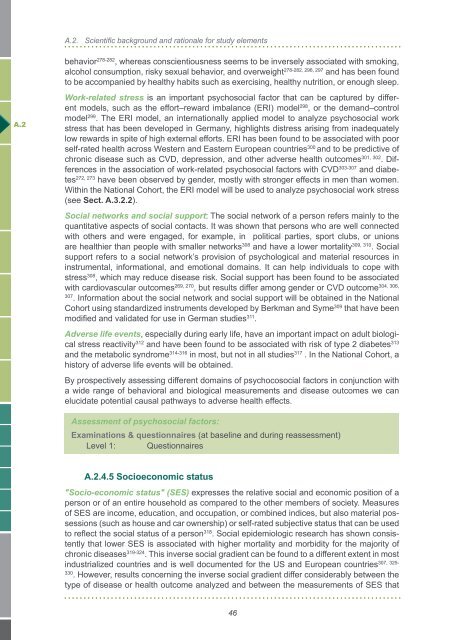Scientific Concept of the National Cohort (status ... - Nationale Kohorte
Scientific Concept of the National Cohort (status ... - Nationale Kohorte
Scientific Concept of the National Cohort (status ... - Nationale Kohorte
You also want an ePaper? Increase the reach of your titles
YUMPU automatically turns print PDFs into web optimized ePapers that Google loves.
A.2<br />
A.2. <strong>Scientific</strong> background and rationale for study elements<br />
behavior 278-282 , whereas conscientiousness seems to be inversely associated with smoking,<br />
alcohol consumption, risky sexual behavior, and overweight 278-282, 296, 297 and has been found<br />
to be accompanied by healthy habits such as exercising, healthy nutrition, or enough sleep.<br />
Work-related stress is an important psychosocial factor that can be captured by different<br />
models, such as <strong>the</strong> effort–reward imbalance (ERI) model 298 , or <strong>the</strong> demand–control<br />
model 299 . The ERI model, an internationally applied model to analyze psychosocial work<br />
stress that has been developed in Germany, highlights distress arising from inadequately<br />
low rewards in spite <strong>of</strong> high external efforts. ERI has been found to be associated with poor<br />
self-rated health across Western and Eastern European countries 300 and to be predictive <strong>of</strong><br />
chronic disease such as CVD, depression, and o<strong>the</strong>r adverse health outcomes 301, 302 . Differences<br />
in <strong>the</strong> association <strong>of</strong> work-related psychosocial factors with CVD 303-307 and diabetes<br />
272, 273 have been observed by gender, mostly with stronger effects in men than women.<br />
Within <strong>the</strong> <strong>National</strong> <strong>Cohort</strong>, <strong>the</strong> ERI model will be used to analyze psychosocial work stress<br />
(see Sect. A.3.2.2).<br />
Social networks and social support: The social network <strong>of</strong> a person refers mainly to <strong>the</strong><br />
quantitative aspects <strong>of</strong> social contacts. It was shown that persons who are well connected<br />
with o<strong>the</strong>rs and were engaged, for example, in political parties, sport clubs, or unions<br />
are healthier than people with smaller networks308 and have a lower mortality309, 310 . Social<br />
support refers to a social network’s provision <strong>of</strong> psychological and material resources in<br />
instrumental, informational, and emotional domains. It can help individuals to cope with<br />
stress308 , which may reduce disease risk. Social support has been found to be associated<br />
with cardiovascular outcomes 269, 270 , but results differ among gender or CVD outcome<br />
46<br />
304, 306,<br />
307 . Information about <strong>the</strong> social network and social support will be obtained in <strong>the</strong> <strong>National</strong><br />
<strong>Cohort</strong> using standardized instruments developed by Berkman and Syme 309 that have been<br />
modified and validated for use in German studies 311 .<br />
Adverse life events, especially during early life, have an important impact on adult biological<br />
stress reactivity 312 and have been found to be associated with risk <strong>of</strong> type 2 diabetes 313<br />
and <strong>the</strong> metabolic syndrome 314-316 in most, but not in all studies 317 . In <strong>the</strong> <strong>National</strong> <strong>Cohort</strong>, a<br />
history <strong>of</strong> adverse life events will be obtained.<br />
By prospectively assessing different domains <strong>of</strong> psychocosocial factors in conjunction with<br />
a wide range <strong>of</strong> behavioral and biological measurements and disease outcomes we can<br />
elucidate potential causal pathways to adverse health effects.<br />
Assessment <strong>of</strong> psychosocial factors:<br />
Examinations & questionnaires (at baseline and during reassessment)<br />
Level 1: Questionnaires<br />
A.2.4.5 Socioeconomic <strong>status</strong><br />
"Socio-economic <strong>status</strong>" (SES) expresses <strong>the</strong> relative social and economic position <strong>of</strong> a<br />
person or <strong>of</strong> an entire household as compared to <strong>the</strong> o<strong>the</strong>r members <strong>of</strong> society. Measures<br />
<strong>of</strong> SES are income, education, and occupation, or combined indices, but also material possessions<br />
(such as house and car ownership) or self-rated subjective <strong>status</strong> that can be used<br />
to reflect <strong>the</strong> social <strong>status</strong> <strong>of</strong> a person318 . Social epidemiologic research has shown consistently<br />
that lower SES is associated with higher mortality and morbidity for <strong>the</strong> majority <strong>of</strong><br />
chronic diseases319-324 . This inverse social gradient can be found to a different extent in most<br />
industrialized countries and is well documented for <strong>the</strong> US and European countries<br />
307, 325-<br />
330 . However, results concerning <strong>the</strong> inverse social gradient differ considerably between <strong>the</strong><br />
type <strong>of</strong> disease or health outcome analyzed and between <strong>the</strong> measurements <strong>of</strong> SES that



